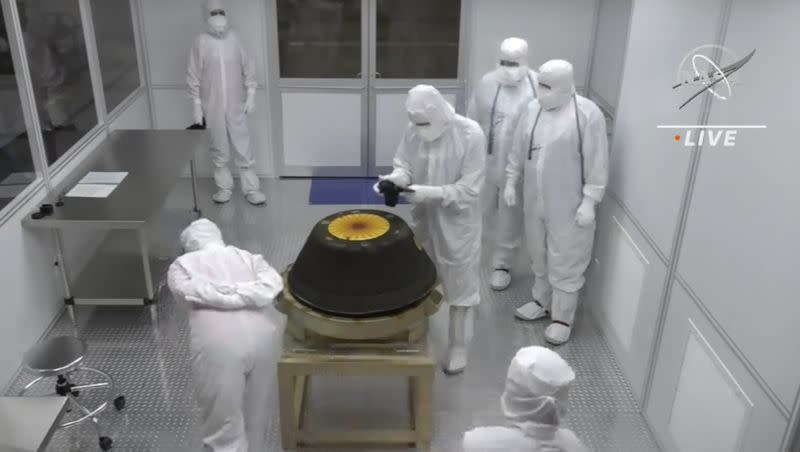Next stop for Bennu asteroid sample? The NASA lab that specializes in extraterrestrial materials

A small but precious sample of material captured from the ancient Bennu asteroid was transported to one of the world’s most specialized labs on Monday after NASA’s Osiris-Rex mission successfully landed a capsule carrying the extraterrestrial dust and rubble in Utah’s west desert on Sunday.
The sample, believed to be about a cup or so of material harvested in deep space by a vacuum-enabled robotic arm deployed by the Osiris-Rex spacecraft that plunged into the surface of Bennu back in 2020, will allow scientists to look back some 4.5 billion years and could reveal new insight into the formation of the solar system and even the origins of water — and life — on Earth.
And the team tasked with the initial processing of the 9 ounces or so of asteroid material is part of a NASA division that’s been assessing extraterrestrial material going back to the early Apollo moon missions over five decades ago.
NASA’s Astromaterials Research & Science Exploration division has been in operation since 1969, the year the Apollo 11 mission, the first to land humans on the moon, brought back the first geologic samples from Earth’s sole satellite. The material included nearly 50 pounds of rocks, regolith (essentially, lunar soil) and core samples gathered by astronauts Neil Armstrong and Buzz Aldrin while on the surface of the moon.
Related
Was there life on Mars? Circle 2033 on your calendar to find out
Earth strikes back: NASA successfully crashes spacecraft into asteroid in planetary defense test
On Monday, an Air Force C-17 airplane transported the Bennu sample, which remained inside a high-tech container extracted from the Osiris-Rex return capsule by gowned technicians Sunday working in a temporary clean room set up at Dugway Proving Ground, to the Johnson Space Center in Houston.
The sample was headed for a new laboratory designed by ARES scientists that is among more than 20 research labs used for the handling and research of ultra-rare materials samples gathered from the cosmos. In its September news letter, ARES noted its scientists were prepared and ready to begin the work of analyzing and cataloging the Bennu sample.
“The (Osiris-Rex) curation lab is ready to receive the samples, and we look forward to working closely with the Osiris-Rex Science team and our international partners (Canadian Space Agency and Japan Aerospace and Exploration Agency) during preliminary examination of the samples,” the ARES newsletter read.
Welcome to Houston, OSIRIS-REx!
The asteroid sample arrived today in Texas where it will be curated and preserved by our team here at Johnson. The information collected could help scientists around the world investigate planetary formation, the origins of life, and how asteroids… pic.twitter.com/8m0Yp3wqap— NASA's Johnson Space Center (@NASA_Johnson) September 25, 2023
NASA reports plans to store about 70% of the Bennu material “for study by scientists not yet born, using technologies not yet invented, to answer fundamental questions about the solar system” with the remainder to be shared among over 200 researchers at 35 institutions around the world.
The ARES scientists will complete a cataloging of the Bennu material and publish results of those efforts in about six months, according to NASA. At that time, investigators outside the Osiris-Rex science team will be able to request samples for research.
The ARES team could be very busy in the coming years thanks to other NASA sample return plans currently under way. Those include additional lunar samples, thanks to the Artemis program which is aiming to land astronauts on the moon in this decade and an effort to bring samples gathered by the Mars Perseverance rover back to Terra Prime in or around 2033.
The Osiris-Rex mission launched from Earth in 2016 on a journey that brought it to an orbit around Bennu in 2018. Bennu is a near-Earth asteroid, meaning it is on a path that orbits the sun. Bennu’s trek around the sun takes 435 days, but every six years the asteroid passes relatively close — within about 186,000 miles — to Earth. For reference, that’s closer to Earth than the moon. Ahead of the opportunity to evaluate material from Bennu, scientists have a wealth of information gathered by Osiris-Rex over the two years it circled and observed the asteroid.
One of the huge advantages of the Bennu sample, from a research perspective, is that the material is “pristine” when compared to samples gathered from meteorites that have crashed to Earth and been contaminated by exposure to the planet’s atmosphere.
Beside its value to scientists as an accessible asteroid that contains material from the earliest days of the solar system, Bennu is also notable as one of the biggest known potential threats for a future collision with Earth.
Research from the Osiris-Rex scientific team estimates there is a 1 in 2,700 chance that Bennu could be on a course to impact earth exactly 159 years from this weekend’s expected landing of Osiris-Rex’s sample return capsule landing, on Sept. 24, 2182.
At the Dugway command center on Sunday, Anjani Polit, mission implementation systems engineer for the Osiris-Rex mission, said that Bennu’s status as a potential Earth-impactor elevates the importance of the information that’s already been gathered about the asteroid as well as what new insights the material sample will reveal.
“The planetary defense aspect is a really important aspect of this mission,” Polit said. “It’s really important to study Bennu ... to evaluate those risks. And also learning about its material properties. What it’s made of ... is information we could use to deflect an asteroid whether it’s Bennu or another asteroid in the future, if we need to.”

